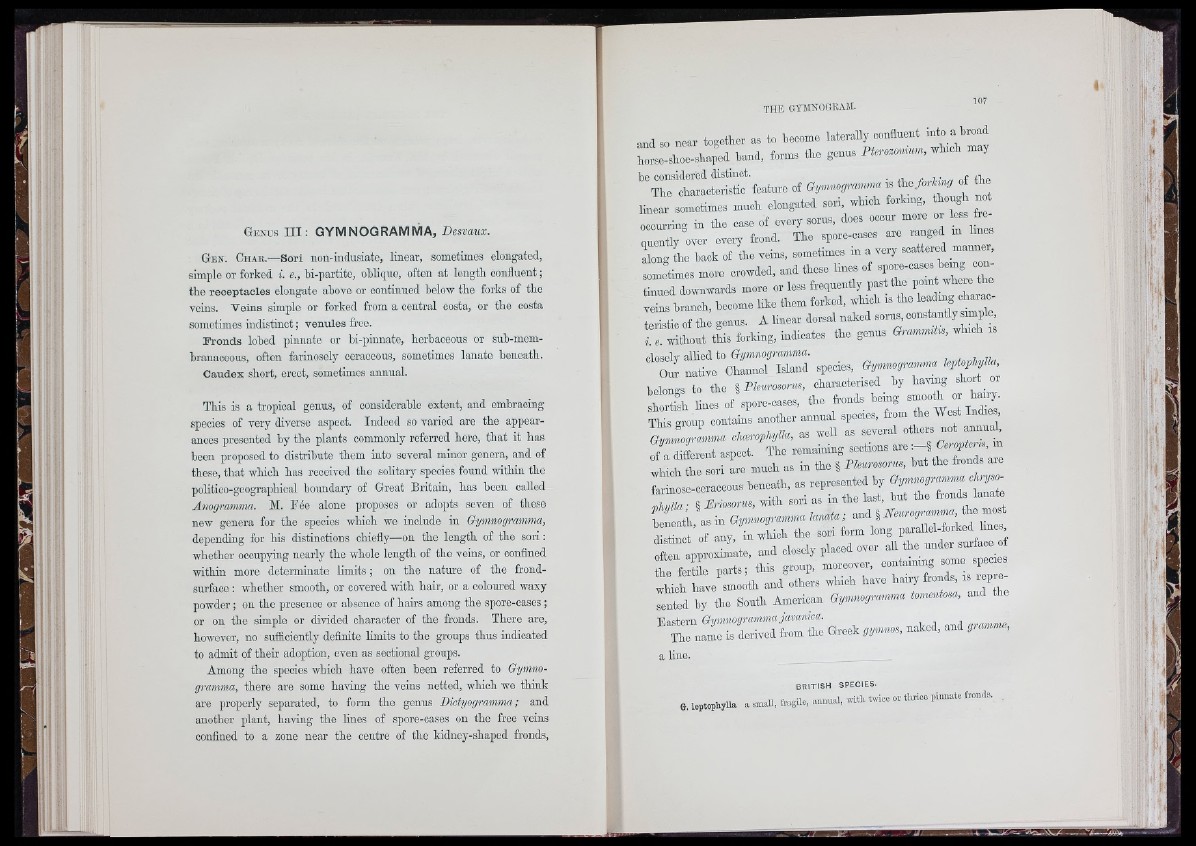
í
5 .
't 'i '
: t
i ■ f G e n u s I I I : GYMNOGRAMMA, Desvaux.
Gen. C h a r.—Sori non-indusiate, linear, sometimes elongated,
simple or forked i. e., bi-partito, oblique, often at length confluent ;
tho receptacles elongate above or continued below the forks of the
veins. Veins simple or forked from a central costa, or the costa
sometimes indistinct ; venules free.
Freu d s lobed pinnate or bi-piimato, herbaceous or sub-mcm-
branacoous, often farinosoly oeraceous, sometimes lanato beneath.
Caudex short, erect, sometimes annual.
This is a tropical genus, of considerable extent, and embracing
species of very diverse aspect. Indeed so varied are tho appearances
presented by the plants commonly referred here, th a t it has
been proposed to distribute them into several minor genera, and of
these, that which has received the solitary species found within the
poKtioo-gcographioal boundary of Groat Britain, has boon called
Anogramma. M. Fee alone proposes or adopts seven of these
new genera for the species which we include in Qymnogramma,
depending for his distinctions chiefly—on the length of the sori :
whether occupying noarly the whole length of the veins, or confined
within more determinate limits ; on the nature of the frond-
surfaoc : whether smooth, or covered with hair, or a coloured waxy
powder ; on the presence or absence of hairs among the sporo-oases ;
or on the simple or divided character of the fronds. There are,
however, no suflioiently definite limits to the groups thus indicated
to admit of their adoption, oven as sectional groups.
Among the species which have often been referred to Qymnogramma,
there are some having the veins netted, which we think
are properly separated, to form the genus Dictyogramma ; and
another plant, having the Knes of spore-casos on tho free veins
confined to a zone near the centre of tho kidney-shaped fronds.
the gymnogram.
„ d „ to g o th o ,. . lo i o „ m .
horso-shoc-shapcd hand, forms the genus Pterozomum, which m y
i: 2 oloodoW » , wMcl « ...g h -
occurring in tho case of every sorus, does occur more or less fre-
quently over every frond. The spore-cases aro ranged in hues
l u g L hack of the veins, somotimos in a very scattered manner,
sometimes more crowded, and these lines of « f ^e-cases being continued
downwards more or less frequently past the point where tho
veins branch, become like them forked, which is the leading characteristic
of the genus. A linear dorsal naked sorus, constantly simple,
i. c. without this forking, indicates the genus QrmmnUs, which is
closely allied to Gymnogramma. , . 7 7 ,
Our native Channel Island species, Gymnogramma hptophylla,
belongs to tho I Pleurosorus, charaotonscd hy having shor or
“ ¿ u . o . . f tfao t a d . t a g —
This group contains another annual species, lom C .V — “ » t a i
/ Gsuect The remaining sections aro .—§ Ceroptens, m
t a c t I t . .ori «re mo e t «. i« the S P i .™ ™ , « "
I r i l e - c e r « » » « b e n e . t t , » r e p r e t a t e d t j f t p » » . » ™ . - « t a l
i Sc - S w i l t t a » m t a t a « tb e t a d . d en.lo
J- u f Af nuv in which the sori form long parallel-forked linos,
I r L l e Z t a i Cl..el7 plaeed e ,e , ... «re » d e r e r r f» et
fertifo narts- this group, moreover, coutaimng some species
w L h have smooth and others which have hairy fronds, is represented
by the South American Gymnogramma tomentosa, and e
. r S t a t G r t a t a d . t a p— .
a lino. _ _
BRITISH SPECIES.
G. leptopRylla a stuan, fragile, adinual. w ith twice or thrice pinrrate fronds.
fk *